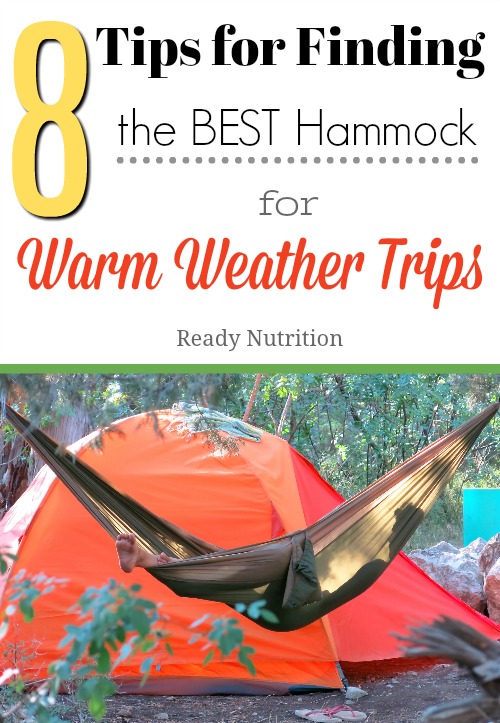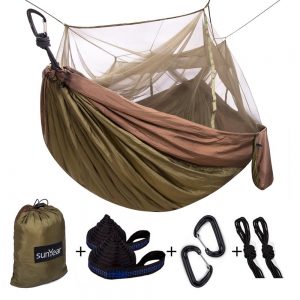
Firstly, the hammock is not a “communal” item: you’ll have to have your own. We used to tote these hammocks around with us in the Service that were basically very little more than a volleyball net with reinforced ends. That being said, look carefully when you pick out your hammock. Cheap you buy, and cheap shall you receive! You need one that you will fit in comfortably.
There are some advantages to using a hammock when you’re camping and on a hike. They’re extremely portable and are able to be either folded up or rolled up and carried in a cargo pocket or stuffed into one of the pockets of your backpack. Then we can take it to another level: the ones made by the U.S. military and classified as “jungle” hammocks. These are the best bets because they have a small canopy over the top, and come complete with mosquito netting. You step into the hammock and zipper up, and you’re protected from the rain and the bugs.
Find the Best Hammock to Suit Your Needs. Follow These Tips for Find the Best Fit!
You can still find these premium hammocks if you enter in “jungle hammocks” or U.S. Army issue jungle hammocks,” and search for it on www.amazon.com. There you’ll find the one that meets your needs. Let’s put out some advice to go along with that hammock when you find the right one.
- The end ropes: Tie off a stick midway on each support rope. The stick should be about 1” in diameter and about a foot-long end to end: affix it to the support rope in the center and spray it down with DEET or another bug repellent that is effective. When the ones that crawl come marching, the coated stick will be a barrier to their advance. Spray the rope about an inch down and up from where you’ve tied the stick.
- Ensure you’re at least 2-3 feet off the ground or more when you’re in the hammock: This means that if you leave 2-3 feet when you tie it off, it will be less distance when you’re in it between you and the ground. Other pests such as rats, mice, snakes, etc., will not be able to bother you if you’re about three feet off the ground or more. The higher the better but remember to make sure you can get in and out of it safely.
- For a non-self-enclosed/open hammock: you can use D-rings to close off the first 1/3 down by the feet…and put your sleeping bag into the hammock. Later when you get in, attach another D-ring up top to make it more snug and secure.
- Open hammocks: If you have those five bungee cords and a poncho (as I mentioned to obtain in other articles), you can rig up a rain shelter…four corners of the grommets lashed off with the bungees. Tie off the hood, and the 5th attaches to a branch to lift the hood vertically, making an angled “roof” that will keep the rain off you.
- BE AWARE OF THE CREATURES! Be aware of bears, mountain lions, wolves, wild boar, or anything else that may be in the vicinity. Know where they are, their trails, and where they lair. Chances are you don’t want to place your hammock near a cave where there is bear scat and tracks in front of its entrance. Also, check for “buddies” such as bees or hornets and indications that the trees you’re using either have them nesting inside of it or in the branches. Better safe than sorry in each case.
- Fall and Winter: Yes, you can still camp out in a hammock even at this time of the year…but you need to make sure you have plenty of insulation in your sleeping bag and a barrier for underneath, such as the poly sleeping pad that is issue to break up the cold from beneath the hammock. Gore-Tex monster needs to come out: pants, top, and polypro. The “Bear” suit would help here, too. If you have no surplus store in your area, you can order all this stuff through amazon.com, and you’ll have it in no time.
- Creature comforts: Take some water to drink and some small snacks up in the hammock with you so that you don’t have to leave frequently. For other “issues,” an empty Gatorade bottle can help you out immensely, and in medical supply stores, an equivalent product can be purchased for ladies who don’t want to leave the hammock. Enough said here, and I’m sure you can figure out what I mean!
- Make sure everyone on the trip knows where everyone else is, either tent or hammock. Motorola radios are a great thing here, as you can have call signs for one another and can then make sure everyone’s alright, as well as alert everyone if there’s a problem. Be smart and affix the Motorola to your chest/front of your shirt so that you won’t have to fumble for it in the dark.
Be aware of your weather patterns. Don’t risk using a hammock when there are high winds or in a very bad storm. Discretion is the better part of valor. The hammock should always be an “adjunct” and used in a survival situation as a last resort, not as your primary means of shelter. An example would be if your tent was burned up by a campfire’s stray embers. Then rely on your poncho and hammock. Find the best one for you and your family, enjoy the outdoors, and be safe. JJ out!

This article was originally published at Ready Nutrition™ on May 26th, 2018







